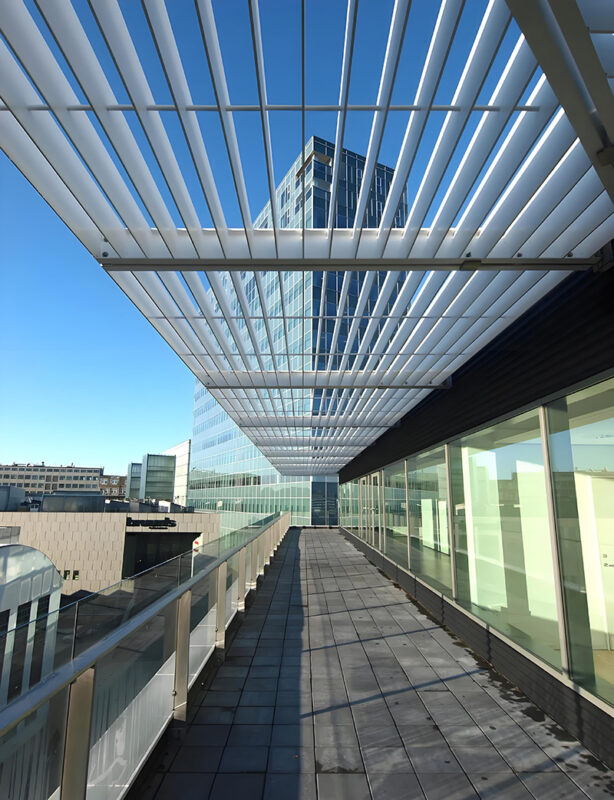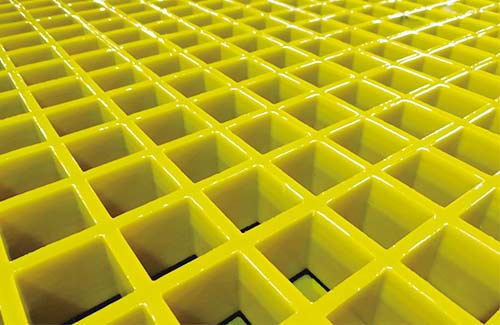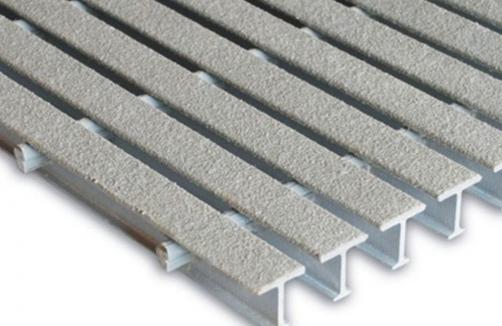Dans le paysage en constante évolution de la construction moderne, la recherche de matériaux innovants susceptibles d'améliorer l'intégrité structurelle, la durabilité et la viabilité est devenue une force motrice pour les architectes, les ingénieurs et les professionnels de la construction. Le caillebotis en polymère renforcé de fibres (PRF) est l'un de ces matériaux qui a changé la donne dans l'industrie. Grâce à sa combinaison unique de propriétés, le caillebotis FRP révolutionne la façon dont les bâtiments et les infrastructures sont conçus, construits et entretenus. Cet article se penche sur les principales caractéristiques du caillebotis FRP, explore ses diverses applications dans la construction moderne et examine le rôle important qu'il joue dans le façonnement de l'avenir de l'industrie architecturale.

Comprendre le caillebotis en polymère renforcé de fibres (PRF)
Le caillebotis en polymère renforcé de fibres (PRF) est un matériau composite composé de brins de fibre de verre noyés dans une matrice de résine polymère. Les brins de fibre de verre, généralement constitués de fibres de verre, offrent une grande résistance à la traction, tandis que la matrice de résine polymère lie les fibres entre elles et les protège de la dégradation de l'environnement. Cette combinaison permet d'obtenir un matériau léger, solide, résistant à la corrosion, non conducteur et ignifuge.
L'un des principaux avantages du caillebotis FRP est son rapport résistance/poids exceptionnel. Comparé aux matériaux traditionnels tels que l'acier et le béton, le caillebotis FRP est beaucoup plus léger, ce qui le rend plus facile à manipuler, à transporter et à installer. Cela permet non seulement de réduire les coûts de main-d'œuvre, mais aussi de minimiser la charge structurelle sur les bâtiments et les infrastructures, ce qui permet des conceptions plus efficaces. En outre, la haute résistance du caillebotis FRP lui permet de supporter de lourdes charges et des conditions environnementales difficiles, ce qui le rend adapté à une large gamme d'applications.
Une autre caractéristique clé du caillebotis FRP est son excellente résistance à la corrosion. Contrairement à l'acier, qui a tendance à rouiller et à se corroder lorsqu'il est exposé à l'humidité, aux produits chimiques et à d'autres substances corrosives, le caillebotis en PRFV est très résistant à ces éléments. Cela en fait un choix idéal pour les applications dans les zones côtières, les usines chimiques, les installations de traitement des eaux usées et d'autres environnements où la corrosion est un problème. La résistance à la corrosion du caillebotis FRP permet non seulement de prolonger sa durée de vie, mais aussi de réduire les coûts d'entretien au fil du temps.
Le caillebotis FRP est également non conducteur, ce qui permet de l'utiliser en toute sécurité dans les environnements électriques. Cette propriété est particulièrement importante dans des applications telles que les centrales électriques, les sous-stations et les installations électriques, où le risque de choc électrique est élevé. En utilisant le caillebotis FRP, les architectes et les ingénieurs peuvent assurer la sécurité des travailleurs et des équipements tout en maintenant l'intégrité structurelle du bâtiment.
Outre ses propriétés mécaniques et physiques, le caillebotis en PRFV est également respectueux de l'environnement. Il est fabriqué à partir de matériaux recyclables et n'émet pas de produits chimiques nocifs ou de polluants pendant sa production ou son utilisation. Cela en fait un choix durable pour les projets de construction modernes, car il contribue à réduire l'impact environnemental de l'industrie du bâtiment.
Applications des caillebotis en PRFV dans la construction moderne
Les propriétés uniques du caillebotis FRP lui permettent de s'adapter à un large éventail d'applications dans la construction moderne. Parmi les domaines clés où le caillebotis FRP est utilisé, on peut citer les suivants :
Planchers et terrasses
Les caillebotis en PRFV sont couramment utilisés pour les revêtements de sol et les terrasses dans les bâtiments industriels, commerciaux et résidentiels. Sa grande solidité, sa résistance au glissement et à la corrosion en font un choix idéal pour les zones où le trafic piétonnier, les équipements ou les véhicules sont importants. Le caillebotis FRP peut être utilisé pour les passerelles, les plates-formes, les mezzanines, les marches d'escalier et d'autres applications de revêtement de sol, offrant une surface sûre et durable qui nécessite un minimum d'entretien.
Toiture et bardage
Les caillebotis en PRFV peuvent également être utilisés pour des applications de toiture et de bardage, offrant une alternative légère et durable aux matériaux traditionnels tels que le métal et l'asphalte. Sa résistance à la corrosion et ses propriétés ignifuges lui permettent d'être utilisé dans des environnements difficiles, tandis que sa nature non conductrice garantit la sécurité des travailleurs lors de l'installation et de l'entretien. Les caillebotis en PRFV peuvent être utilisés pour les toits plats, les toits en pente, les puits de lumière et d'autres applications de toiture, ainsi que pour le revêtement extérieur et le bardage.
Composants structurels
Les caillebotis en PRFV peuvent être utilisés comme éléments structurels dans les bâtiments et les infrastructures, offrant une alternative solide et légère aux matériaux traditionnels tels que l'acier et le béton. Son rapport résistance/poids élevé et sa résistance à la corrosion permettent de l'utiliser dans des applications porteuses, telles que les poutres, les colonnes et les poutrelles. Le caillebotis FRP peut également être utilisé pour renforcer les structures en béton, améliorant ainsi leur résistance et leur durabilité.
Drainage et filtration
Les caillebotis en PRFV sont couramment utilisés pour les applications de drainage et de filtration dans les installations de traitement des eaux usées, les systèmes de gestion des eaux pluviales et d'autres projets d'ingénierie environnementale. Sa grande solidité, sa résistance à la corrosion et sa conception ouverte en font un choix idéal pour les grilles de drainage, les couvertures de tranchées et les supports de médias filtrants. Les caillebotis en PRFV peuvent également être utilisés pour la séparation huile-eau, la sédimentation et d'autres processus de filtration, offrant ainsi une solution rentable et efficace pour la protection de l'environnement.
Sûreté et sécurité
Les caillebotis en PRFV sont souvent utilisés pour des applications de sécurité dans les bâtiments et les infrastructures, offrant une surface antidérapante et durable qui aide à prévenir les accidents et les blessures. Sa grande solidité et sa résistance à la corrosion permettent de l'utiliser dans des zones où la sécurité est une préoccupation, telles que les escaliers, les rampes, les passerelles et les plates-formes. Le caillebotis FRP peut également être utilisé pour les clôtures de sécurité, les barrières et autres mesures de protection, offrant ainsi une solution fiable et rentable pour les applications de sécurité.

Le rôle des caillebotis en PRFV dans le façonnement de l'avenir de la construction
L'utilisation du caillebotis FRP dans la construction moderne ne se limite pas à ses applications actuelles, mais a également le potentiel de façonner l'avenir de l'industrie. Voici quelques-unes des façons dont le caillebotis FRP devrait influencer l'avenir de la construction :
Construction durable
Alors que la demande de pratiques de construction durables continue de croître, les caillebotis en PRFV sont appelés à jouer un rôle important dans l'industrie. Ses matériaux recyclables, son faible impact sur l'environnement et sa longue durée de vie en font un choix durable pour les projets de construction modernes. En utilisant le caillebotis FRP, les architectes et les ingénieurs peuvent réduire l'empreinte carbone des bâtiments et des infrastructures, tout en améliorant leur efficacité énergétique et leur durabilité.
Techniques avancées de conception et de construction
Les propriétés uniques du caillebotis en PRFV devraient également permettre le développement de techniques de conception et de construction avancées. Son rapport résistance/poids élevé et sa flexibilité permettent de créer des structures complexes et innovantes qui n'étaient pas possibles auparavant avec les matériaux traditionnels. Le caillebotis FRP peut également être utilisé en combinaison avec d'autres matériaux, tels que le béton et l'acier, pour créer des structures hybrides qui offrent le meilleur des deux mondes.
Amélioration de la sûreté et de la sécurité
L'utilisation des caillebotis en PRFV dans les applications de sécurité devrait continuer à se développer à l'avenir, à mesure que la demande de bâtiments et d'infrastructures plus sûrs et plus sécurisés augmentera. Sa surface antidérapante et durable, ainsi que sa grande solidité et sa résistance à la corrosion, en font un choix idéal pour les zones où la sécurité est une préoccupation. Le caillebotis FRP peut également être utilisé pour les clôtures de sécurité, les barrières et autres mesures de protection, offrant ainsi une solution fiable et rentable pour les applications de sécurité.
Des solutions rentables
Malgré ses propriétés avancées, le caillebotis FRP est une solution rentable pour les projets de construction modernes. Ses faibles coûts d'entretien, sa longue durée de vie et sa facilité d'installation en font un choix plus économique que les matériaux traditionnels tels que l'acier et le béton. En utilisant le caillebotis FRP, les architectes et les ingénieurs peuvent réduire le coût global des projets de construction, tout en améliorant leur qualité et leur performance.
En conclusion, le caillebotis en polymère renforcé de fibres (PRF) est un matériau révolutionnaire qui transforme la façon dont les bâtiments et les infrastructures sont conçus, construits et entretenus. Sa combinaison unique de propriétés, telles que la haute résistance, la légèreté, la résistance à la corrosion, la non-conductivité et l'ignifugation, le rend adapté à une large gamme d'applications dans la construction moderne. La demande de pratiques de construction durable, de techniques de conception et de construction avancées, d'amélioration de la sûreté et de la sécurité et de solutions rentables ne cessant de croître, le rôle des caillebotis en PRFV dans l'avenir de la construction devrait devenir encore plus important. Les architectes, les ingénieurs et les professionnels de la construction devraient envisager d'utiliser le caillebotis PRFV dans leurs projets afin de profiter de ses nombreux avantages et de garder une longueur d'avance dans le domaine en constante évolution de la construction moderne.







